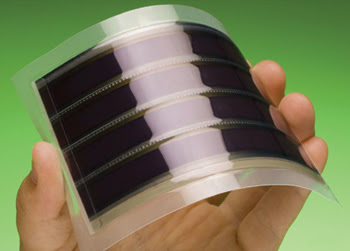Researchers molecularly modify a sensitizer to improve conversion efficiency.
Michael A. Greenwood, News Editor
Although many people regard solar power as a near-perfect form of energy, investigators first will have to overcome two stubborn problems if the renewable resource is ever to move into the mainstream.
The twin pitfalls of cost and performance continue to bedevil solar technology.
Researchers at the University of Tokyo and at Ecole Polytechnique Fédérale de Lausanne in Switzerland report that they have developed through chemical engineering a novel breed of organic dye sensitizer that could contribute to the eventual fabrication of solar cells that are less expensive and more efficient than those being produced now.

Researchers have chemically engineered a dye-sensitized flexible solar cell with indoline, resulting in improved performance and less bulk. Courtesy of Shaik M. Zakeeruddin.
As detailed in the Feb. 22, 2008, issue of Angewandte Chemie, the sensitizers are based on the dye indoline and achieve a power conversion efficiency of ∼7.2 percent, a level that the researchers say is a record for dye-sensitized solar cells based on ionic liquids and organic dyes.
Lead researcher Michael Grätzel of Ecole Polytechnique Fédérale de Lausanne previously had developed photoelectrochemical solar cells that were easy to produce and that could withstand prolonged exposure to light and heat. These “Grätzel cells” feature a layer of TiO2 particles coated with a sensitizing dye.
For this cell to work properly, the electrons injected into the TiO2 must not recombine with the oxidized dye. To prevent this from happening, the team introduced an electrolyte solution with negatively charged iodide and tri-iodide ions into the cells, which chemically reduced the holes created in the dye. This created another issue, however, in that the volatile organic solvent in the electrolyte required the encapsulation of the electrolyte.
The researchers believe that ionic liquids with organic sensitizers are a viable alternative to these unpredictable solvents. In place of the usual ruthenium dyes, Satoshi Uchida’s team from the University of Tokyo engineered an organic dye based on indoline. Known as D205, it enabled the group to build a solar cell that was thinner and that reduced the length that an electron has to travel.
It achieved higher levels of performance than similar dyes through the extension of its alkyl chain on the terminal rhodanine moiety from ethyl to octyl.
During experiments with the dyes, the researchers found that D205 yielded a number of promising results. In tests to see how well these dye-based cells convert solar to electrical power, the team exposed three differently engineered indoline dyes to various light intensities. In each case, the D205 dye outperformed the other two, achieving an efficiency of 7.18 percent when exposed to the equivalent of 1.0 sunlight intensity. The D205 dye achieved an even higher conversion efficiency of 7.92 percent when exposed to a lower sunlight intensity of 0.3. This increased efficiency occurs because, at lower light levels, the photocurrents are smaller, resulting in a decrease in mass-transfer-related losses.
Additionally, the team observed that, compared with the two other dyes that were made from the same substance but that had undergone different chemical engineering, the D205 dye exhibited a longer electron lifetime at a variety of open circuit potentials.
Grätzel said the results show that the performance of dye-based solar cells can be changed rather dramatically through even subtle modifications to the chemical design of the sensitizer.